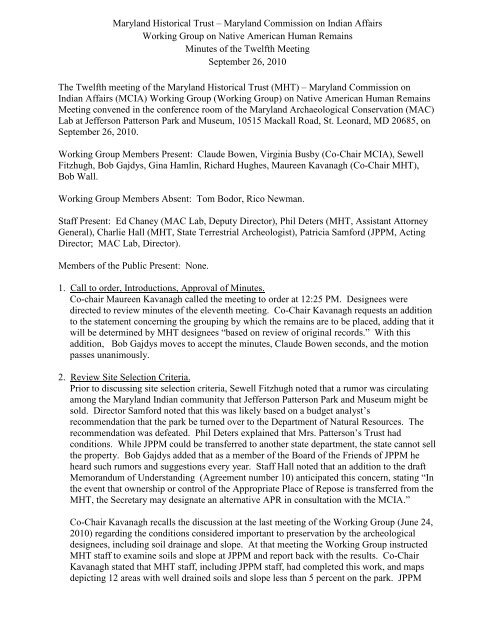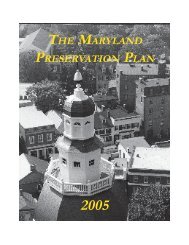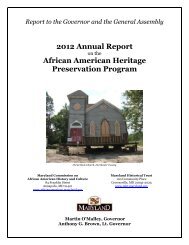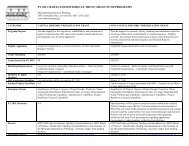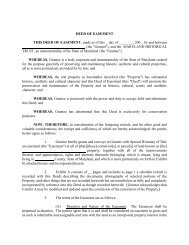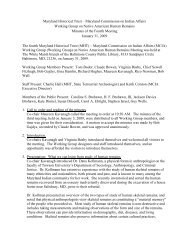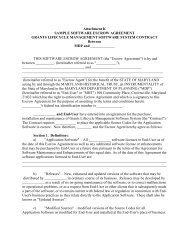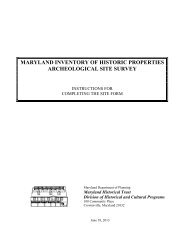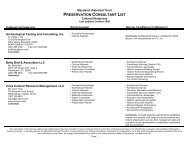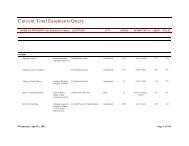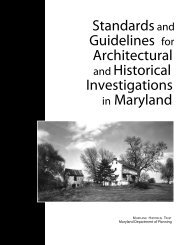September 26, 2010 - Maryland Historical Trust
September 26, 2010 - Maryland Historical Trust
September 26, 2010 - Maryland Historical Trust
- No tags were found...
You also want an ePaper? Increase the reach of your titles
YUMPU automatically turns print PDFs into web optimized ePapers that Google loves.
<strong>Maryland</strong> <strong>Historical</strong> <strong>Trust</strong> – <strong>Maryland</strong> Commission on Indian AffairsWorking Group on Native American Human RemainsMinutes of the Twelfth Meeting<strong>September</strong> <strong>26</strong>, <strong>2010</strong>The Twelfth meeting of the <strong>Maryland</strong> <strong>Historical</strong> <strong>Trust</strong> (MHT) – <strong>Maryland</strong> Commission onIndian Affairs (MCIA) Working Group (Working Group) on Native American Human RemainsMeeting convened in the conference room of the <strong>Maryland</strong> Archaeological Conservation (MAC)Lab at Jefferson Patterson Park and Museum, 10515 Mackall Road, St. Leonard, MD 20685, on<strong>September</strong> <strong>26</strong>, <strong>2010</strong>.Working Group Members Present: Claude Bowen, Virginia Busby (Co-Chair MCIA), SewellFitzhugh, Bob Gajdys, Gina Hamlin, Richard Hughes, Maureen Kavanagh (Co-Chair MHT),Bob Wall.Working Group Members Absent: Tom Bodor, Rico Newman.Staff Present: Ed Chaney (MAC Lab, Deputy Director), Phil Deters (MHT, Assistant AttorneyGeneral), Charlie Hall (MHT, State Terrestrial Archeologist), Patricia Samford (JPPM, ActingDirector; MAC Lab, Director).Members of the Public Present: None.1. Call to order, Introductions, Approval of Minutes.Co-chair Maureen Kavanagh called the meeting to order at 12:25 PM. Designees weredirected to review minutes of the eleventh meeting. Co-Chair Kavanagh requests an additionto the statement concerning the grouping by which the remains are to be placed, adding that itwill be determined by MHT designees “based on review of original records.” With thisaddition, Bob Gajdys moves to accept the minutes, Claude Bowen seconds, and the motionpasses unanimously.2. Review Site Selection Criteria.Prior to discussing site selection criteria, Sewell Fitzhugh noted that a rumor was circulatingamong the <strong>Maryland</strong> Indian community that Jefferson Patterson Park and Museum might besold. Director Samford noted that this was likely based on a budget analyst’srecommendation that the park be turned over to the Department of Natural Resources. Therecommendation was defeated. Phil Deters explained that Mrs. Patterson’s <strong>Trust</strong> hadconditions. While JPPM could be transferred to another state department, the state cannot sellthe property. Bob Gajdys added that as a member of the Board of the Friends of JPPM heheard such rumors and suggestions every year. Staff Hall noted that an addition to the draftMemorandum of Understanding (Agreement number 10) anticipated this concern, stating “Inthe event that ownership or control of the Appropriate Place of Repose is transferred from theMHT, the Secretary may designate an alternative APR in consultation with the MCIA.”Co-Chair Kavanagh recalls the discussion at the last meeting of the Working Group (June 24,<strong>2010</strong>) regarding the conditions considered important to preservation by the archeologicaldesignees, including soil drainage and slope. At that meeting the Working Group instructedMHT staff to examine soils and slope at JPPM and report back with the results. Co-ChairKavanagh stated that MHT staff, including JPPM staff, had completed this work, and mapsdepicting 12 areas with well drained soils and slope less than 5 percent on the park. JPPM
Working Group on Native American Human RemainsMinutes of the Twelfth Meeting, page 2staff described each of the 12 areas with respect to location, acreage, current and future use,and vegetation/cultivation. An MCIA designee wondered if any of the 12 areas was near adocumented Indian archeological site. Co-Chair Busby noted that many Indian archeologicalsites had been identified on park property, and as a result all of JPPM could be consideredNative land. Two of the 12 areas are currently wooded and/or wetland, and two are currentlyused for event parking. Another consideration discussed was the remoteness of the sites,which could be a detriment to security. Four of the 12 areas are so remote as to presentsecurity issues. The Working Group agreed to eliminate these eight areas from furtherconsideration, unless a suitable area could not be found among the remaining four.3. Tour property to review potential locations for Appropriate Place of Repose.The Working Group left the MAC Lab at 1:00 PM to examine each of the four areas.One of the areas (#10) was judged too close to a public road. One (#6) was found to bepartially wooded and partially used for parking, leaving too little area for the purpose. Of theremaining two areas, one had a water view (#4) and the other did not (#9).4. Review locations and issues; outline next steps.The Working Group reconvened in the MAC Lab conference room at 2:15 PM.A number of issues were discussed, beginning with proposed changes since the draft MOUhad been circulated by email to all the designees. The placing of a benchmark near theAppropriate Place of Repose was questioned, and Staff Hall showed the designees a picture ofwhat was intended (2” diameter brass surveyor’s benchmark, to be set near ground surface inconcrete). The potential need for mediation, in the event of a future disagreement, wasdiscussed. Assistant Attorney General Deters suggested that the MOU be amended by addinga sentence: “In the event of any proposed modification to this MOU or any dispute betweenthe parties under this MOU, the MCIA shall consult with the <strong>Maryland</strong> Indian communities.”Costs associated with establishing this Appropriate Place of Repose were discussed, and alldesignees agreed that those associated with the preparation of the land would be borne by theState, while those associated with the preparation of the remains would be borne by the<strong>Maryland</strong> Indian community.Co-Chair Kavanagh calls for comments regarding the four areas inspected. All were inagreement that the area with a water view was the most desirable for the Appropriate Place ofRepose among those inspected. No objections were raised to the following consensusstatement:Area #4 shall be forwarded to the Secretary as the Working Group’srecommendation for the Appropriate Place of Repose at JeffersonPatterson Park and Museum.Discussion of the next steps resulted in the following priority schedule:First, send the recommendation to the Secretary.Second, prepare the area (clear it of vegetation, etcetera).Third, have the clay tablets made.Fourth, ready the remains for placement.
Working Group on Native American Human RemainsMinutes of the Twelfth Meeting, page 3Preparation of the remains for placement in the Appropriate Place of Repose may involvewrapping them in fabric (red cotton) and the inclusion of other materials.The Working Group expressed its hope that the MOU could be finalized and sent to theSecretary by the end of October, signed by all parties by the end of November, and theremains in the ground by the end of the year.The desirability of a press release was discussed and all agreed that any discussions with thepress should be vague. In general, the designees felt that the less publicity the better.Co-Chair Kavanagh drew the designee’s attention to the other remains and the need to discussseveral outstanding issues that attend to them, including the need for additional study of someof the remains, and defining acceptable locations.Gina Hamlin moved that the meeting be adjourned, Virginia Busby seconded, and the motionwas passed unanimously.The meeting was adjourned at 3:20 PM.


